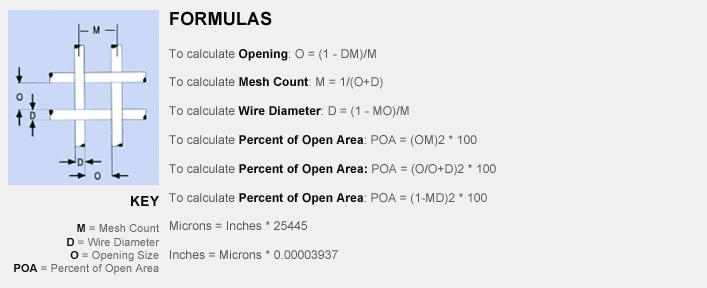Wire Mesh & Wire Cloth Terms & Tools
Wire Mesh & Wire Cloth Terms & Tools
When choosing your preferred wire mesh or wire cloth, please refer to Dorstener Wire Tech's full wire mesh and wire cloth glossary of terms for your reference. Contact us for more information or assistance.

Absolute Filtration RatingThe diameter of the largest hard spherical particle that will pass through a filter under specified test conditions. This is an indication of the largest opening in the filter cloth.
Air Flow/Air PermeabilityMeasure of the amount of air that flows through a filter–a variable of the degree of contamination, differential pressure, total porosity, and filter area. Expressed in either cubic feet/minute/square foot or liters/minute/square centimeter at a given pressure.
ApertureSee Mesh Opening.
Binding (Plugged)A filter element that has collected a sufficient quantity of insoluble contaminants such that it can no longer pass rated flow without excessive differential pressure.
Bolting GradeUsed in sifting and sizing applications and general filtration applications. Higher percent of open area compared to market and mill grade. Usually woven in a square weave.
Bubble Point TestA test to determine the maximum pore size opening of a filter.
CalendaringA process by which fabric or wire is passed through a pair of heavy rollers to reduce thickness, to flatten the intersections of the threads/wires and to control air permeability. Rollers are heated when calendaring synthetic materials.
Clear OpeningsSpace between adjacent parallel wires. (also Space)
CrimpCorrugations in wire to permit locking them in place when perpendicular to each other.
Differential PressureThe difference in pressure between two points of a system, such as between two sides of an orifice
DownstreamThe side of a product stream that has already passed through a given filter system; portion located after the filtration unit.
Dutch WeaveWarp and weft wire diameters are different in size and the weft wires are closer together to provide excellent strength and high density.
Effective AreaThe total area of the porous medium exposed to flow in a filter element.
EfficiencyThe ability, expressed as a percent, of a filter to remove specified artificial contaminant at a given contaminant concentration under specified test conditions.
Filter LifeMeasure of the duration of a filter's useful service. This is based on the amount of standard contaminant required to cause differential pressure to increase to an unacceptable level-typically 2-4 times the initial differential pressure, a 50-80% drop in initial flow, or an unacceptable downstream measure of particulate.
Filter MediaA porous material for separating suspended particulate matter from fluid.
FiltrationA process of separating particulate matter from a fluid by passing it through a permeable material.
Flow RateMeasure of the amount of fluid passing through the filter. This is always a variable of filter area, porosity, contamination and differential pressure.
Market GradeMost commonly used sizes of industrial wire cloth specifications selected for general purpose work.
Micronic Filter ClothVery durable and strong cloth. Also referred to as "Dutch Weave". Usually supplied in a twilled Durch or plain Dutch weave depending on the mesh count. Normally used in filtration applications such as pressure filters, fuel filters, and many more.
Mill GradeUsed mostly in sifting and sizing applications. Higher percent of open area compared to market grade. Usually woven in a square weave.
Mean Filtration RatingDerived from Bubble Point test method. Data should be used as a guide only to compare overall retention capabilities between fabrics and should not be considered a guarantee of the particle size that the fabric will retain.
MeshNumber of openings in a linear inch measured from the center of one wire to a point 1" distant.
Mesh CountThe number of threads in a linear centimeter or inch of fabric/wire cloth.
Mesh OpeningMesh opening is the difference between wires measured in the warp and weft direction in the projected plane of the wire mesh.
Open AreaThe proportion of total screen area that is open space. Expressed as a percentage.
Pore SizeFilters are rated according to the size of particles they can remove. Particles which are bigger than indicated pore size, are removed. Smaller particles pass through the fabric The size of particles is measured in micro-meters or "microns" one micron being equal to one-millionth of a meter or one-thousandth of a millimeter, the size of coal dust or baking flour. The smallest bacteria are about ½.
Pre-Crimp MeshThe wire is crimped prior to weaving. Mostly limited to coarse mesh with larger wire diameters.
Selvage EdgesA loom finished edge that prevents cloth unraveling.
SeparationThis process divides or separates a mixture of particles or liquids into separate components.
Square WeaveSee Plain Weave.
Space ClothThis mesh has a clear opening size. 1" X 1" Space Cloth has a 1" clear opening. 1 X 1 mesh has lass than a 1" opening.
Strainer GradeWire cloth with a rectangular opening. Also referred to as an oblong mesh and off-count mesh. Used in filtration and straining applications.
Twill WeaveFormed by passing the warp or weft fiber over two or more fibers in the opposite direction.
Warp WiresWire running the length of the cloth as woven.
Weft Or Shute WiresFibers or wires running across the width of the cloth as woven.
Wire DiameterSee Thread diameter.